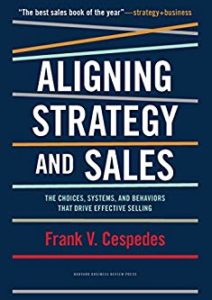Interview with Frank Cespedes, Part 1
Frank Cespedes teaches at Harvard Business School, and is the author of Aligning Strategy and Sales: The Choices, Systems, and Behaviors that Drive Effective Selling (Harvard Business Review Press), which was cited as “the best sales book of the year” (Strategy + Business), “a must read” (Gartner Group), and “perhaps the best sales book ever” (Forbes).
This is part 1 of a 2 part interview with Frank on the crucial subject of aligning sales efforts with company strategy.
1. Why is it important to connect selling to company strategy, and what are some suggestions for getting a sales organization to do that?
U.S. companies spend over $900 billion annually on sales efforts—the compensation, travel, benefits and support expenses associated with field, inside, and other selling investments. That’s more than three times what they spend on all advertising, and orders of magnitude more than their current spend on digital marketing efforts and social media. For most companies, sales is—by far—the biggest and most expensive part of strategy implementation.
Conversely, there is no such thing as effective selling if it’s not connected to strategic goals. It may be good for the individual rep and his or her bonus, but it doesn’t serve enterprise value. To connect selling with strategy, I would begin with the following areas, one of which is primarily a C-Suite responsibility and the other is a sales manager’s responsibility.
a) Make sure your company in fact has a coherent strategy and communicate it.
Many executives confuse a “Mission” or “Vision” or financial “Goal” with strategy. That’s a mistake. Strategy is more than picking a big number or grand aspiration and then giving it your best effort. It’s a linked series of choices and investments about where to play (and where not to play) in a market, and how. Those choices affect who are target customers, the relevant value proposition, the nature of the buying journey that the seller encounters, and other core sales tasks.
Then, you must communicate those choices because it’s difficult for people, including salespeople, to do what they don’t understand. Most companies are not good at this. Surveys indicate that fewer than 50% of employees say they understand their firm’s strategy. In fact, the percentage of people who say they understand their firm’s strategy decreases the closer you get to the customer—that is, in the responses of people in sales and service functions.
Developing and communicating a coherent strategy is a leadership responsibility. It’s tough to make good things happen in any business without a strategy that is understood by the people who deal with prospects and customers.
b) Translate strategy into relevant sales behaviors via performance management practices.
Choices, market segmentation, and other aspects of strategy formulation set the stage. But in any business, a “market” doesn’t buy anything; only customers do. That’s where sales leaders make—or should make—their biggest contribution: translating those strategic choices into relevant selling behaviors. Among other things, they do this through two core performance management practices: sales compensation incentives and performance reviews.
Surveys indicate that about 70% of sales comp plans bonus reps for sales volume irrespective of the margins, profitability, after-sale service, or other components of cost-to-serve customers. Notice the message here: “go forth and multiply” because any customer is a good customer with this incentive plan. Sales people then bring in orders with often contradictory implications for investments in product, service and other parts of the business. Soon, this is how the company is really allocating its resources, not according to the plans discussed in the C-Suite. Data-analytics make this disconnect increasingly apparent, and it’s an area where sales and non-sales executives need better dialogue.
And because customers and not markets do the buying, and sales people not “the company” do the selling, performance reviews and the metrics used to evaluate performance are crucial alignment tools. Too often, busy sales managers treat reviews as cursory, drive-by conversations about past quota attainment, not coaching and discussions about going-forward behaviors. Doing good reviews is a trainable skill and, in my experience, many sales organizations have much room to improve.
2. Why is it important to understand opportunity cost?
Opportunity cost is what you forgo when you choose X rather than Y or Z. The goal of strategy is profitable growth, meaning economic value above the firm’s cost of capital. Opportunity cost is central to economic value, and much of sales is all about understanding and managing opportunities. In any business, the money, time, and attention spent pursuing and servicing account A are resources not available for accounts B, C and so on. Despite what you sometimes hear during a bubble, there is indeed no free lunch and opportunity costs are an inescapable fact of business and life.
Relatively few firms and sales leaders clarify their opportunity selection criteria. Either directly in sales meetings, or implicitly in the compensation plan, most are saying: sell to anyone willing to pay a certain price (often discounted to make a volume quota target). This approach inhibits learning and can blind managers to what is actually going on in customer acquisition and retention efforts. In a competitive market, ineffective opportunity management eventually leads to loss of money, time and brand positioning with customers who are (or should be) core customers for the firm. Over time, moreover, it leads to the nurturing of “commodity competencies”: the sales force and company gets better and better at activities that customers value less and less.
Most markets present firms with an array of opportunities. Success is aligning your selling program with the opportunities pursued. Failure in opportunity management comes in two forms—what statisticians call type 1 and type 2 errors. Type 1 error is approaching transaction buyers with a service-intensive, solutions-selling approach. This is a direct financial cost to the firm, and type 1 errors plague many established category leaders. Notice how many tales of disruptive innovation are about high-end providers still trying to sell feature-rich product/service bundles to customers not interested in paying for what they have come to see as an “over-engineered” solution versus new alternatives.
Type 2 error is approaching a solution opportunity with a transaction approach. In this situation, the seller is not really part of the customer’s choice set. The opportunity cost is that the seller loses a chance to compete in a market where it wants or needs to compete. Most firms have financial systems that track revenues minus expenses and thus the financial costs of Type 1 errors. But Type 2 errors are more subtle and can repeat with more frequency, putting an often unexpected ceiling on sales and growth.
Either way, opportunity cost is real in sales. You can pretend it’s not there, but it is. And it’s not the responsibility of the customer to tell you when you are barking up the wrong tree. It’s the seller’s responsibility to make that judgment about opportunities.














Comments